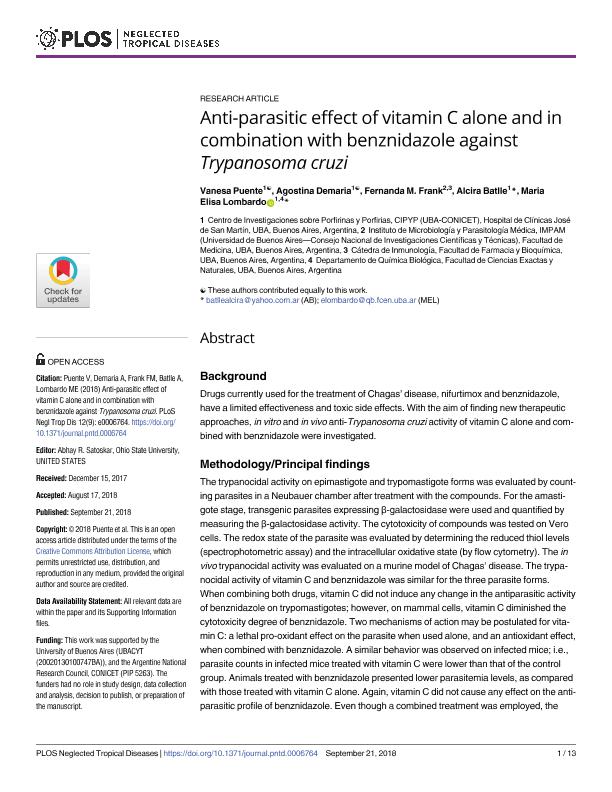Mostrar el registro sencillo del ítem
dc.contributor.author
Puente, Vanesa Rocío

dc.contributor.author
Demaria, Agostina
dc.contributor.author
Frank, Fernanda María

dc.contributor.author
Batlle, Alcira María del C.

dc.contributor.author
Lombardo, Maria Elisa

dc.date.available
2019-10-22T18:40:23Z
dc.date.issued
2018-09
dc.identifier.citation
Puente, Vanesa Rocío; Demaria, Agostina; Frank, Fernanda María; Batlle, Alcira María del C.; Lombardo, Maria Elisa; Anti-parasitic effect of vitamin C alone and in combination with benznidazole against Trypanosoma cruzi; Public Library of Science; PLoS Neglected Tropical Diseases; 12; 9; 9-2018; 1-13
dc.identifier.issn
1935-2735
dc.identifier.uri
http://hdl.handle.net/11336/86956
dc.description.abstract
Background: Drugs currently used for the treatment of Chagas’ disease, nifurtimox and benznidazole, have a limited effectiveness and toxic side effects. With the aim of finding new therapeutic approaches, in vitro and in vivo anti-Trypanosoma cruzi activity of vitamin C alone and combined with benznidazole were investigated. Methodology/Principal findings: The trypanocidal activity on epimastigote and trypomastigote forms was evaluated by counting parasites in a Neubauer chamber after treatment with the compounds. For the amastigote stage, transgenic parasites expressing β-galactosidase were used and quantified by measuring the β-galactosidase activity. The cytotoxicity of compounds was tested on Vero cells. The redox state of the parasite was evaluated by determining the reduced thiol levels (spectrophotometric assay) and the intracellular oxidative state (by flow cytometry). The in vivo trypanocidal activity was evaluated on a murine model of Chagas’ disease. The trypanocidal activity of vitamin C and benznidazole was similar for the three parasite forms. When combining both drugs, vitamin C did not induce any change in the antiparasitic activity of benznidazole on trypomastigotes; however, on mammal cells, vitamin C diminished the cytotoxicity degree of benznidazole. Two mechanisms of action may be postulated for vitamin C: a lethal pro-oxidant effect on the parasite when used alone, and an antioxidant effect, when combined with benznidazole. A similar behavior was observed on infected mice; i.e., parasite counts in infected mice treated with vitamin C were lower than that of the control group. Animals treated with benznidazole presented lower parasitemia levels, as compared with those treated with vitamin C alone. Again, vitamin C did not cause any effect on the antiparasitic profile of benznidazole. Even though a combined treatment was employed, the antioxidant effect of vitamin C on the host was evidenced; a 100% survival was observed and the weight loss occurring during the acute phase of the infection was reduced. Conclusions/Significance: Based on these results, the combination of vitamin C with benznidazole could be considered as an alternative treatment for Chagas’ disease. These preliminary results encourage further research to improve the treatment of Chagas’ disease.
dc.format
application/pdf
dc.language.iso
eng
dc.publisher
Public Library of Science

dc.rights
info:eu-repo/semantics/openAccess
dc.rights.uri
https://creativecommons.org/licenses/by-nc-sa/2.5/ar/
dc.subject
Trypanosoma cruzi
dc.subject
Vitamin C
dc.subject
Treatment
dc.subject.classification
Medicina Tropical

dc.subject.classification
Ciencias de la Salud

dc.subject.classification
CIENCIAS MÉDICAS Y DE LA SALUD

dc.title
Anti-parasitic effect of vitamin C alone and in combination with benznidazole against Trypanosoma cruzi
dc.type
info:eu-repo/semantics/article
dc.type
info:ar-repo/semantics/artículo
dc.type
info:eu-repo/semantics/publishedVersion
dc.date.updated
2019-10-10T15:00:28Z
dc.identifier.eissn
1935-2735
dc.journal.volume
12
dc.journal.number
9
dc.journal.pagination
1-13
dc.journal.pais
Estados Unidos

dc.journal.ciudad
San Francisco
dc.description.fil
Fil: Puente, Vanesa Rocío. Consejo Nacional de Investigaciones Científicas y Técnicas. Oficina de Coordinación Administrativa Houssay. Centro de Investigaciones sobre Porfirinas y Porfirias. Universidad de Buenos Aires. Centro de Investigaciones sobre Porfirinas y Porfirias; Argentina
dc.description.fil
Fil: Demaria, Agostina. Consejo Nacional de Investigaciones Científicas y Técnicas. Oficina de Coordinación Administrativa Houssay. Centro de Investigaciones sobre Porfirinas y Porfirias. Universidad de Buenos Aires. Centro de Investigaciones sobre Porfirinas y Porfirias; Argentina
dc.description.fil
Fil: Frank, Fernanda María. Consejo Nacional de Investigaciones Científicas y Técnicas. Oficina de Coordinación Administrativa Houssay. Instituto de Investigaciones en Microbiología y Parasitología Médica. Universidad de Buenos Aires. Facultad de Medicina. Instituto de Investigaciones en Microbiología y Parasitología Médica; Argentina
dc.description.fil
Fil: Batlle, Alcira María del C.. Consejo Nacional de Investigaciones Científicas y Técnicas. Oficina de Coordinación Administrativa Houssay. Centro de Investigaciones sobre Porfirinas y Porfirias. Universidad de Buenos Aires. Centro de Investigaciones sobre Porfirinas y Porfirias; Argentina
dc.description.fil
Fil: Lombardo, Maria Elisa. Consejo Nacional de Investigaciones Científicas y Técnicas. Oficina de Coordinación Administrativa Houssay. Centro de Investigaciones sobre Porfirinas y Porfirias. Universidad de Buenos Aires. Centro de Investigaciones sobre Porfirinas y Porfirias; Argentina
dc.journal.title
PLoS Neglected Tropical Diseases

dc.relation.alternativeid
info:eu-repo/semantics/altIdentifier/doi/http://dx.doi.org/10.1371/journal.pntd.0006764
dc.relation.alternativeid
info:eu-repo/semantics/altIdentifier/url/https://journals.plos.org/plosntds/article?id=10.1371/journal.pntd.0006764
Archivos asociados
